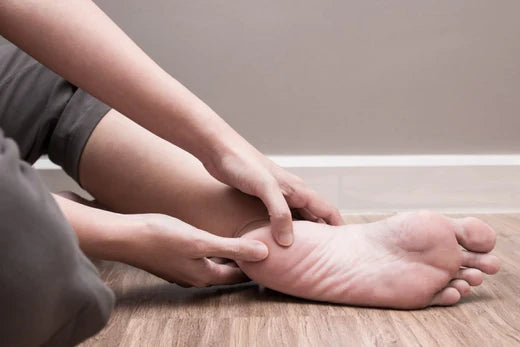Weightlifting Injuries: Sprained Ankle (And How to Prevent One)

A common weightlifting injury among athletes and casual gym goers alike, a sprained ankle can quickly put a stop to any fitness goals you have.
Your ankle is made up of ligaments that help to orchestrate the synchronicity between bones and muscle tissue. Ligaments are tough but they have their limits. Push a ligament past its threshold of capability and you wind up with a tear and a sprained ankle.
Let’s take a look at the most common causes of a sprained ankle in weightlifting and what you can do to prevent it.
Causes of a Sprained Ankle in Weightlifting
Weightlifting by itself isn’t a cause of a sprained ankle. However, there are variables surrounding your workout that can increase your risk of a tear.
Plyometrics: Also known as jump training, plyometrics is a type of high-impact exercise that is commonly used for athletes. If you have little to no experience using plyometric drills, we advise avoiding them or starting slow with basic movements such as jump squats. Avoid agility drills until you build up the strength of your ankle.
Wrong Footwear: Depending on what type of workout you’re doing, if you’re wearing inappropriate footwear, this will increase your risk of a sprained ankle. Avoid overly padded shoes as they work against your natural movement patterns. Also, make sure you keep your athletic shoes in good condition. If they are looking beat up, get a new pair.
Bad Form: If you don’t know how to perfectly execute a lower-body exercise, you immediately increase your risk for a sprained ankle. Now add to that a loaded barbell and you can see how you’ll get into trouble. Before attempting any exercise with weight plates, you need to ensure you know what you’re doing on a squat rack. This might mean hiring a trainer for a month to coach you, but the investment will pay for itself immediately.
How to Prevent a Sprained Ankle
Here are the best ways to prevent a sprained ankle so you stay safe and on track for your fitness goals.
Warm-Up and Stretch Properly
We know it’s not the most glamorous part of your workout, but we can’t stress this enough: you need to warm-up and stretch.
First, your warm-up should consist of light cardio – something to get the blood pumping and to increase your heart rate.
Ankle-safe warm-ups include the elliptical, stair stepper, and rowing machine.
Next, it’s time to stretch. Before your workout, you should focus on primarily dynamic stretching. This is when you perform light versions of the workout to follow. For example, if you’re planning on performing barbell back squats, the dynamic stretch would be air squats.
The exception is with your ankle. Incorporate this static stretch:
- Face a wall and place your hands on it at shoulder level.
- Slide your right foot back.
- Bend the left knee.
- Lean forward until you feel a stretch from your foot to your knee.
- Make sure to keep the back heel on the ground throughout.
- Hold this stretch for up to 45 seconds.
- Switch sides.
- Repeat two or three times.
Perform Balance Drills
Instead of focusing on weight-bearing exercises, give yourself some time each week to include balance drills. This will strengthen your ankle while improving mobility and balance.
Single-Leg Variations: Using one leg for an exercise can dramatically increase your balance. Stand next to a wall or stable surface and try performing single-leg squats, Romanian deadlifts, and leg raises. You can also stand in place, lift your knee to hip level, and hold this for 60 seconds.
BOSU Variations: The next level up would be performing lower body movements on the BOSU. You can use either side to perform squats, lunges, and deadlifts.
Strengthen the Ankle
If your ankle is feeling good, you have no prior issues, and you want to get it seriously strong, you can incorporate some resistance-based exercises using resistance bands.
Attach the resistance band to a secure surface and perform the following movements:
Resistance Band Dorsiflexion: Run the band across the top of the foot. Slowly move your foot upward, fighting against the resistance. Slowly return your foot to the starting position and repeat for 15 repetitions on each side.
Resistance Band Plantarflexion: Run the band across the bottom of your foot. Slowly push against the band, moving your foot down. Hold and slowly return. Repeat for 15 repetitions on each side.
You don’t necessarily need resistance bands for these next two exercises, but they would be useful.
Inversion: Standing on your left leg, move the right foot inward toward the center of your body. Repeat for 15 repetitions on both sides.
Eversion: Standing on your left leg, move the right foot outward. Repeat for 15 repetitions on both sides.
Listen to Your Body
Finally, the best way to avoid a sprained ankle is to listen to your body. Yes, it’s important to push yourself outside of your comfort zone but not at the cost of an injury.
Use auto-regulatory training methods during workouts. In other words, check in with yourself after each exercise. Take note if your ankle feels stressed or sore. If it is, stop performing that exercise and move on to something else such as ankle stretching.
What Will You Do to Prevent a Sprained Ankle During Weightlifting?
Have a video of yourself performing the ankle exercises listed above? Tag on us Instagram so we can share your video!


